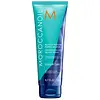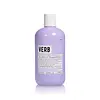What's inside
What's inside
 Key Ingredients
Key Ingredients

 Benefits
Benefits

 Concerns
Concerns

 Ingredients Side-by-side
Ingredients Side-by-side

Water
Skin ConditioningSodium C14-16 Olefin Sulfonate
CleansingCocamidopropyl Betaine
CleansingCocamidopropylamine Oxide
CleansingParfum
MaskingGuar Hydroxypropyltrimonium Chloride
Skin ConditioningArgania Spinosa Kernel Oil
EmollientPEG-40 Hydrogenated Castor Oil
EmulsifyingAcrylates Copolymer
PEG-150 Distearate
EmulsifyingGlycol Stearate
EmollientHydroxyacetophenone
AntioxidantAlgin
MaskingGlycerin
HumectantChitosan
Trideceth-9
EmulsifyingC12-13 Pareth-9
EmulsifyingC11-15 Pareth-7
EmulsifyingC12-16 Pareth-9
EmulsifyingSilica Dimethyl Silylate
EmollientIsopropyl Alcohol
SolventTrideceth-12
EmulsifyingCitric Acid
BufferingCoconut Acid
CleansingCocamidopropyl Dimethylamine
EmulsifyingCaprylyl Glycol
EmollientCetrimonium Chloride
AntimicrobialSodium Glycolate
BufferingCI 60730
Cosmetic ColorantTrimethylsiloxyamodimethicone
Caprylic/Capric Triglyceride
MaskingPhenoxyethanol
PreservativeChlorphenesin
AntimicrobialPotassium Sorbate
PreservativeSodium Benzoate
MaskingAlpha-Isomethyl Ionone
PerfumingLinalool
PerfumingWater, Sodium C14-16 Olefin Sulfonate, Cocamidopropyl Betaine, Cocamidopropylamine Oxide, Parfum, Guar Hydroxypropyltrimonium Chloride, Argania Spinosa Kernel Oil, PEG-40 Hydrogenated Castor Oil, Acrylates Copolymer, PEG-150 Distearate, Glycol Stearate, Hydroxyacetophenone, Algin, Glycerin, Chitosan, Trideceth-9, C12-13 Pareth-9, C11-15 Pareth-7, C12-16 Pareth-9, Silica Dimethyl Silylate, Isopropyl Alcohol, Trideceth-12, Citric Acid, Coconut Acid, Cocamidopropyl Dimethylamine, Caprylyl Glycol, Cetrimonium Chloride, Sodium Glycolate, CI 60730, Trimethylsiloxyamodimethicone, Caprylic/Capric Triglyceride, Phenoxyethanol, Chlorphenesin, Potassium Sorbate, Sodium Benzoate, Alpha-Isomethyl Ionone, Linalool
Water
Skin ConditioningSodium Lauroyl Sarcosinate
CleansingCocamide Mea
EmulsifyingGlycerin
HumectantCocamidopropyl Betaine
CleansingDisodium Laureth Sulfosuccinate
CleansingSodium C14-16 Olefin Sulfonate
CleansingLaureth-3
EmulsifyingDimethyl Isosorbide
SolventBoswellia Carterii Oil
MaskingEuterpe Oleracea Fruit Extract
Panthenol
Skin ConditioningAnhydroxylitol
HumectantCalcium Gluconate
HumectantCarnosine
Skin ConditioningGluconolactone
Skin ConditioningHydroxypropylammonium Gluconate
HumectantHydroxypropylgluconamide
HumectantMaltodextrin
AbsorbentXylitol
HumectantXylitylglucoside
HumectantMaleic Acid
BufferingGlycol Distearate
EmollientTrideceth-12
EmulsifyingGlycol Stearate
EmollientPEG-150 Distearate
EmulsifyingPEG-12 Dimethicone
Skin ConditioningParfum
MaskingPolyquaternium-7
Polyquaternium-10
Quaternium-80
Sarcosine
Skin ConditioningAcrylates/C10-30 Alkyl Acrylate Crosspolymer
Emulsion StabilisingAmodimethicone
Lauric Acid
CleansingXanthan Gum
EmulsifyingHydroxypropyl Guar Hydroxypropyltrimonium Chloride
Sodium Chloride
MaskingPotassium Sorbate
PreservativeSodium Benzoate
MaskingCetrimonium Chloride
AntimicrobialPEG-12 Allyl Ether
Citric Acid
BufferingBHT
AntioxidantLinoleamidopropyl Pg-Dimonium Chloride Phosphate Dimethicone
Sodium Sulfate
Propylene Glycol
HumectantSodium Acetate
BufferingIsopropyl Alcohol
SolventBenzyl Alcohol
PerfumingSilica
AbrasiveDehydroacetic Acid
PreservativeTartaric Acid
BufferingCI 60730
Cosmetic ColorantAmyl Cinnamal
PerfumingBenzyl Cinnamate
PerfumingBenzyl Salicylate
PerfumingCitral
PerfumingCitronellol
PerfumingGeraniol
PerfumingHexyl Cinnamal
PerfumingHydroxycitronellal
PerfumingButylphenyl Methylpropional
PerfumingLimonene
PerfumingLinalool
PerfumingAlpha-Isomethyl Ionone
PerfumingWater, Sodium Lauroyl Sarcosinate, Cocamide Mea, Glycerin, Cocamidopropyl Betaine, Disodium Laureth Sulfosuccinate, Sodium C14-16 Olefin Sulfonate, Laureth-3, Dimethyl Isosorbide, Boswellia Carterii Oil, Euterpe Oleracea Fruit Extract, Panthenol, Anhydroxylitol, Calcium Gluconate, Carnosine, Gluconolactone, Hydroxypropylammonium Gluconate, Hydroxypropylgluconamide, Maltodextrin, Xylitol, Xylitylglucoside, Maleic Acid, Glycol Distearate, Trideceth-12, Glycol Stearate, PEG-150 Distearate, PEG-12 Dimethicone, Parfum, Polyquaternium-7, Polyquaternium-10, Quaternium-80, Sarcosine, Acrylates/C10-30 Alkyl Acrylate Crosspolymer, Amodimethicone, Lauric Acid, Xanthan Gum, Hydroxypropyl Guar Hydroxypropyltrimonium Chloride, Sodium Chloride, Potassium Sorbate, Sodium Benzoate, Cetrimonium Chloride, PEG-12 Allyl Ether, Citric Acid, BHT, Linoleamidopropyl Pg-Dimonium Chloride Phosphate Dimethicone, Sodium Sulfate, Propylene Glycol, Sodium Acetate, Isopropyl Alcohol, Benzyl Alcohol, Silica, Dehydroacetic Acid, Tartaric Acid, CI 60730, Amyl Cinnamal, Benzyl Cinnamate, Benzyl Salicylate, Citral, Citronellol, Geraniol, Hexyl Cinnamal, Hydroxycitronellal, Butylphenyl Methylpropional, Limonene, Linalool, Alpha-Isomethyl Ionone
Ingredients Explained
These ingredients are found in both products.
Ingredients higher up in an ingredient list are typically present in a larger amount.
Alpha-Isomethyl Ionone is a fragrance. It can be synthetically created or naturally occurring.
The scent of Alpha-Isomethyl Ionone is described as "flowery" but can also be "woody".
Naturally occurring Alpha-Isomethyl Ionone may be found in Saccharomyces cerevisiae, or the yeast used to make wine and bread.
The term 'fragrance' is not regulated in many countries. In many cases, it is up to the brand to define this term. For instance, many brands choose to label themselves as "fragrance-free" because they are not using synthetic fragrances. However, their products may still contain ingredients such as essential oils that are considered a fragrance.
Learn more about Alpha-Isomethyl IononeThis ingredient is a preservative, antimicrobial, and emulsifier. It is often used in cosmetics for its ability to cleanse, condition, and reduce static.
Cetrimonium chloride is a quaternary ammonium salt, meaning it has a water-soluble structure.
This ingredient is a purple dye. It is also known as Violet No. 2 or Acid Violet 43 and is a synthetic dye derived from coal tar.
According to a manufacturer, this dye it known for its intense color saturation and resistance to fading.
Citric Acid is an alpha hydroxy acid (AHA) naturally found in citrus fruits like oranges, lemons, and limes.
Like other AHAs, citric acid can exfoliate skin by breaking down the bonds that hold dead skin cells together. This helps reveal smoother and brighter skin underneath.
However, this exfoliating effect only happens at high concentrations (20%) which can be hard to find in cosmetic products.
Due to this, citric acid is usually included in small amounts as a pH adjuster. This helps keep products slightly more acidic and compatible with skin's natural pH.
In skincare formulas, citric acid can:
While it can provide some skin benefits, research shows lactic acid and glycolic acid are generally more effective and less irritating exfoliants.
Most citric acid used in skincare today is made by fermenting sugars (usually from molasses). This synthetic version is identical to the natural citrus form but easier to stabilize and use in formulations.
Read more about some other popular AHA's here:
Learn more about Citric AcidCocamidopropyl Betaine is a fatty acid created by mixing similar compounds in coconut oil and dimethylaminopropylamine, a compound with two amino groups.
This ingredient is a surfactant and cleanser. It helps gather the dirt, pollutants, and other impurities in your skin to be washed away. It also helps thicken a product and make the texture more creamy.
Being created from coconut oil means Cocamidopropyl Betaine is hydrating for the skin.
While Cocamidopropyl Betaine was believed to be an allergen, a study from 2012 disproved this. It found two compounds in unpure Cocamidopropyl Betaine to be the irritants: aminoamide and 3-dimethylaminopropylamine. High-grade and pure Cocamidopropyl Betaine did not induce allergic reactions during this study.
Learn more about Cocamidopropyl BetaineGlycerin is already naturally found in your skin. It helps moisturize and protect your skin.
A study from 2016 found glycerin to be more effective as a humectant than AHAs and hyaluronic acid.
As a humectant, it helps the skin stay hydrated by pulling moisture to your skin. The low molecular weight of glycerin allows it to pull moisture into the deeper layers of your skin.
Hydrated skin improves your skin barrier; Your skin barrier helps protect against irritants and bacteria.
Glycerin has also been found to have antimicrobial and antiviral properties. Due to these properties, glycerin is often used in wound and burn treatments.
In cosmetics, glycerin is usually derived from plants such as soybean or palm. However, it can also be sourced from animals, such as tallow or animal fat.
This ingredient is organic, colorless, odorless, and non-toxic.
Glycerin is the name for this ingredient in American English. British English uses Glycerol/Glycerine.
Learn more about GlycerinGlycol Stearate comes from stearic acid and ethylene glycol.
It is a creamy wax used to stabilize ingredients as an emulsifier. Glycol stearate also contains emollient properties. Emollients sit on top of the skin to prevent moisture from escaping.
This ingredient may not be Malassezia folliculitis, or fungal-acne safe.
Learn more about Glycol StearateIsopropyl Alcohol is more commonly known as rubbing alcohol. It is most commonly used as a solvent, meaning it helps other ingredients dissolve.
This ingredient is an astringent alcohol. Astringent alcohols may also irritate skin as they high amounts may strip away your skin's natural oils.
Other types of astringent alcohols include:
According to the National Rosacea Society based in the US, you should be mindful of products with these alcohols in the top half of ingredients.
Any type of sanitizing product will have high amounts of alcohol to help kill bacteria and viruses.
Learn more about Isopropyl AlcoholLinalool is a fragrance and helps add scent to products. It's derived from common plants such as cinnamon, mint, citrus, and lavender.
Like Limonene, this ingredient oxidizes when exposed to air. Oxidized linalool can cause allergies and skin sensitivity.
This ingredient has a scent that is floral, spicy tropical, and citrus-like.
Learn more about LinaloolParfum is a catch-all term for an ingredient or more that is used to give a scent to products.
Also called "fragrance", this ingredient can be a blend of hundreds of chemicals or plant oils. This means every product with "fragrance" or "parfum" in the ingredients list is a different mixture.
For instance, Habanolide is a proprietary trade name for a specific aroma chemical. When used as a fragrance ingredient in cosmetics, most aroma chemicals fall under the broad labeling category of “FRAGRANCE” or “PARFUM” according to EU and US regulations.
The term 'parfum' or 'fragrance' is not regulated in many countries. In many cases, it is up to the brand to define this term.
For instance, many brands choose to label themselves as "fragrance-free" because they are not using synthetic fragrances. However, their products may still contain ingredients such as essential oils that are considered a fragrance by INCI standards.
One example is Calendula flower extract. Calendula is an essential oil that still imparts a scent or 'fragrance'.
Depending on the blend, the ingredients in the mixture can cause allergies and sensitivities on the skin. Some ingredients that are known EU allergens include linalool and citronellol.
Parfum can also be used to mask or cover an unpleasant scent.
The bottom line is: not all fragrances/parfum/ingredients are created equally. If you are worried about fragrances, we recommend taking a closer look at an ingredient. And of course, we always recommend speaking with a professional.
Learn more about ParfumPeg-150 Distearate is an emulsifier and thickening agent. It is created from stearic acid.
As an emulsifier, peg-150 distearate helps other ingredients dissolve. This helps prevent ingredient separation.
This ingredient may not be Malassezia folliculitis, or fungal-acne safe.
Learn more about PEG-150 DistearatePotassium Sorbate is a preservative used to prevent yeast and mold in products. It is commonly found in both cosmetic and food products.
This ingredient comes from potassium salt derived from sorbic acid. Sorbic acid is a natural antibiotic and effective against fungus.
Both potassium sorbate and sorbic acid can be found in baked goods, cheeses, dried meats, dried fruit, ice cream, pickles, wine, yogurt, and more.
You'll often find this ingredient used with other preservatives.
Learn more about Potassium SorbateSodium Benzoate is a preservative. It's used in both cosmetic and food products to inhibit the growth of mold and bacteria. It is typically produced synthetically.
Both the US FDA and EU Health Committee have approved the use of sodium benzoate. In the US, levels of 0.1% (of the total product) are allowed.
Sodium benzoate works as a preservative by inhibiting the growth of bacteria inside of cells. It prevents the cell from fermenting a type of sugar using an enzyme called phosphofructokinase.
It is the salt of benzoic acid. Foods containing sodium benzoate include soda, salad dressings, condiments, fruit juices, wines, and snack foods.
Studies for using ascorbic acid and sodium benzoate in cosmetics are lacking, especially in skincare routines with multiple steps.
We always recommend speaking with a professional, such as a dermatologist, if you have any concerns.
Learn more about Sodium BenzoateSodium C14-16 Olefin Sulfonate is a cleansing agent made from a mixture of long chain sulfonate salts. It can also help produce foam.
This ingredient may be drying. We recommend speaking with a professional if you have concerns.
We don't have a description for Trideceth-12 yet.
Water. It's the most common cosmetic ingredient of all. You'll usually see it at the top of ingredient lists, meaning that it makes up the largest part of the product.
So why is it so popular? Water most often acts as a solvent - this means that it helps dissolve other ingredients into the formulation.
You'll also recognize water as that liquid we all need to stay alive. If you see this, drink a glass of water. Stay hydrated!
Learn more about Water